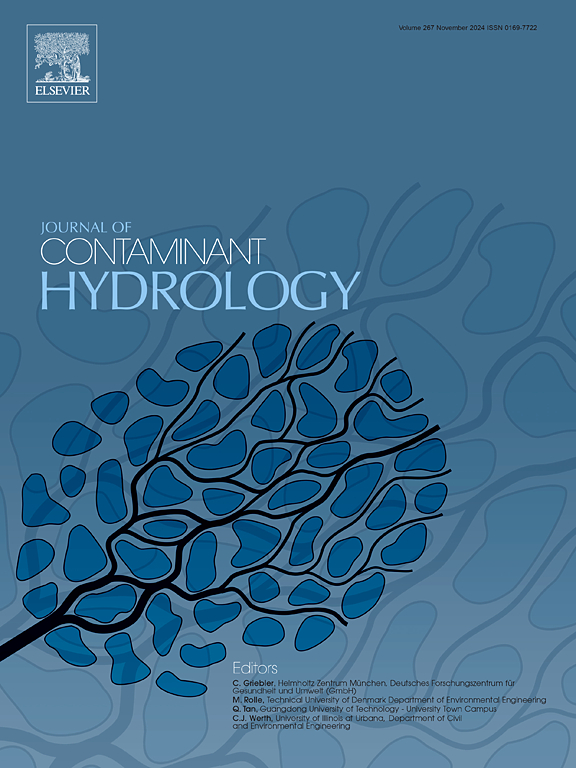Identifying an indicator compound for progress monitoring during in-situ thermal treatment of coal tar and creosote
IF 3.5
3区 环境科学与生态学
Q2 ENVIRONMENTAL SCIENCES
引用次数: 0
Abstract
In situ thermal treatment (ISTT) has been used to treat sites impacted by coal tar and creosote when stringent remediation objectives must be met over short timeframes. There is a need to identify an indicator compound that can be used to track progress during the treatment of these complex semi-volatile non-aqueous phase liquids (NAPLs) to complement soil sampling typically conducted once treatment is complete. This study outlines an approach to track ISTT progress and support shutdown decisions based on mass removal objectives using a series of laboratory experiments to investigate changes in semi-volatile NAPL composition during thermal treatment. Sand, water and semi-volatile NAPL were heated, and the recovery of polycyclic aromatic hydrocarbons (PAHs) was monitored by sampling and analysis of condensate. PAHs were predominantly removed between 260 °C and 455 °C, with early-stage condensate composed of higher volatility PAHs and later-stage condensate composed of lower volatility PAHs. Experimental results showed that intermediate-volatility PAHs (e.g., phenanthrene) could be used as an indicator compound to infer treatment progress with respect to both higher and lower volatility PAHs. Monitoring an indicator compound during ISTT of semi-volatile NAPL could provide higher confidence in treatment progress than conventional monitoring techniques and allow for more accurate shutdown decisions.

确定一种用于煤焦油和杂酚油原位热处理过程监测的指示化合物。
当必须在短时间内达到严格的修复目标时,原位热处理(ISTT)已被用于处理受煤焦油和杂酚油影响的场地。需要确定一种指示化合物,用于跟踪这些复杂的半挥发性非水相液体(NAPLs)处理过程中的进展,以补充通常在处理完成后进行的土壤采样。本研究概述了一种跟踪ISTT进展的方法,并基于质量去除目标支持关闭决策,使用一系列实验室实验来研究热处理过程中半挥发性NAPL成分的变化。加热砂、水和半挥发性NAPL,通过对凝析油取样和分析,监测多环芳烃(PAHs)的回收率。在260°C ~ 455°C之间,PAHs主要被去除,早期凝析油由高挥发性PAHs组成,而后期凝析油由低挥发性PAHs组成。实验结果表明,中挥发性多环芳烃(如菲)可以作为一种指标化合物来推断高挥发性和低挥发性多环芳烃的处理进展。与传统的监测技术相比,在半挥发性NAPL的ISTT期间监测指示剂化合物可以对处理进展提供更高的信心,并允许更准确的关闭决策。
本文章由计算机程序翻译,如有差异,请以英文原文为准。
求助全文
约1分钟内获得全文
求助全文
来源期刊

Journal of contaminant hydrology
环境科学-地球科学综合
CiteScore
6.80
自引率
2.80%
发文量
129
审稿时长
68 days
期刊介绍:
The Journal of Contaminant Hydrology is an international journal publishing scientific articles pertaining to the contamination of subsurface water resources. Emphasis is placed on investigations of the physical, chemical, and biological processes influencing the behavior and fate of organic and inorganic contaminants in the unsaturated (vadose) and saturated (groundwater) zones, as well as at groundwater-surface water interfaces. The ecological impacts of contaminants transported both from and to aquifers are of interest. Articles on contamination of surface water only, without a link to groundwater, are out of the scope. Broad latitude is allowed in identifying contaminants of interest, and include legacy and emerging pollutants, nutrients, nanoparticles, pathogenic microorganisms (e.g., bacteria, viruses, protozoa), microplastics, and various constituents associated with energy production (e.g., methane, carbon dioxide, hydrogen sulfide).
The journal''s scope embraces a wide range of topics including: experimental investigations of contaminant sorption, diffusion, transformation, volatilization and transport in the surface and subsurface; characterization of soil and aquifer properties only as they influence contaminant behavior; development and testing of mathematical models of contaminant behaviour; innovative techniques for restoration of contaminated sites; development of new tools or techniques for monitoring the extent of soil and groundwater contamination; transformation of contaminants in the hyporheic zone; effects of contaminants traversing the hyporheic zone on surface water and groundwater ecosystems; subsurface carbon sequestration and/or turnover; and migration of fluids associated with energy production into groundwater.
 求助内容:
求助内容: 应助结果提醒方式:
应助结果提醒方式:


